Sustainable Construction Management Strategies
VerifiedAdded on 2020/06/06
|13
|4183
|34
AI Summary
This assignment is a literature review focusing on sustainable construction management strategies. It specifically examines methods for monitoring, diagnosing, and retrofitting building energy performance during the operation and maintenance phase. The review draws upon academic research papers published between 2015 and 2017, covering topics such as IT operations management, product development, water resource management, renewable energy systems, and smart grid technologies.
Contribute Materials
Your contribution can guide someone’s learning journey. Share your
documents today.
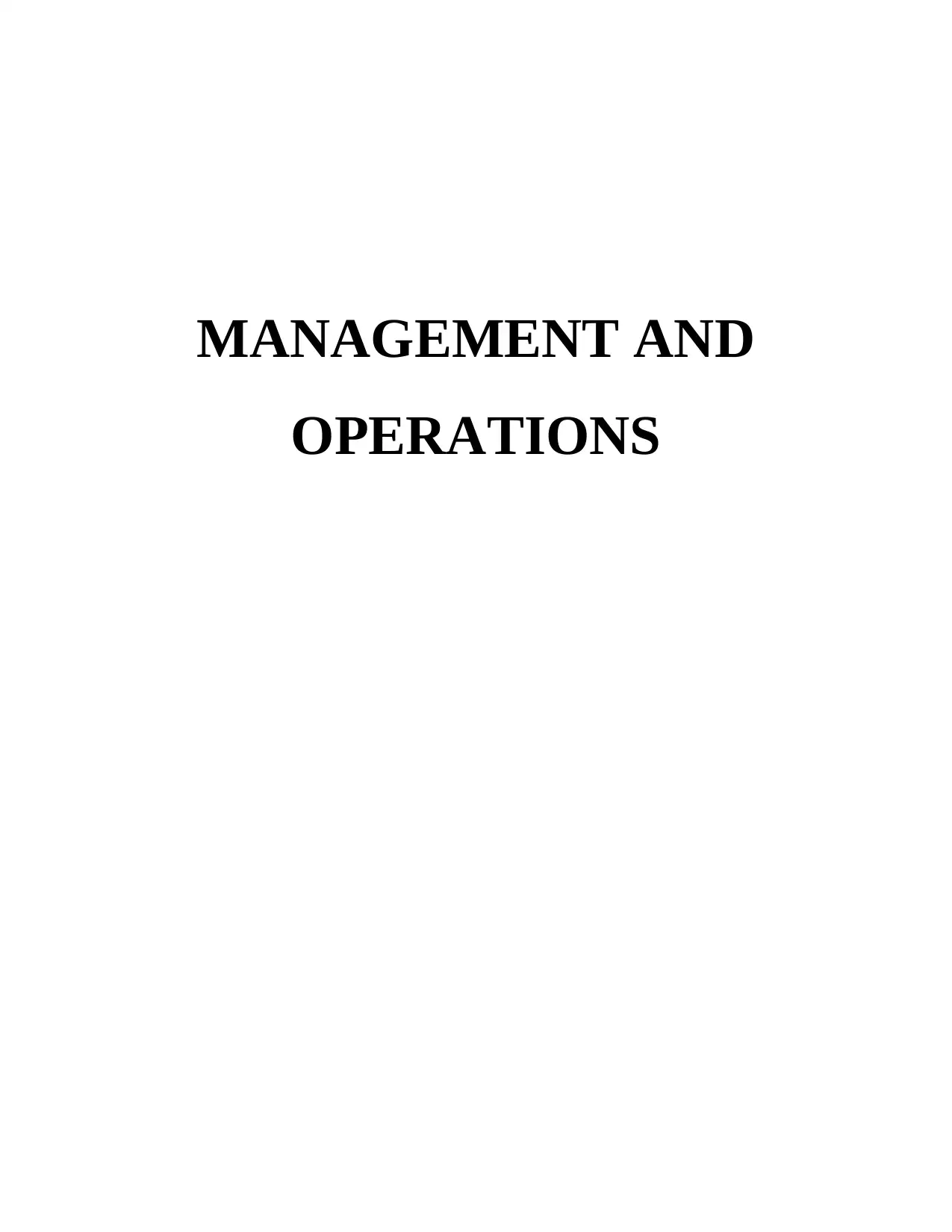
MANAGEMENT AND
OPERATIONS
OPERATIONS
Secure Best Marks with AI Grader
Need help grading? Try our AI Grader for instant feedback on your assignments.
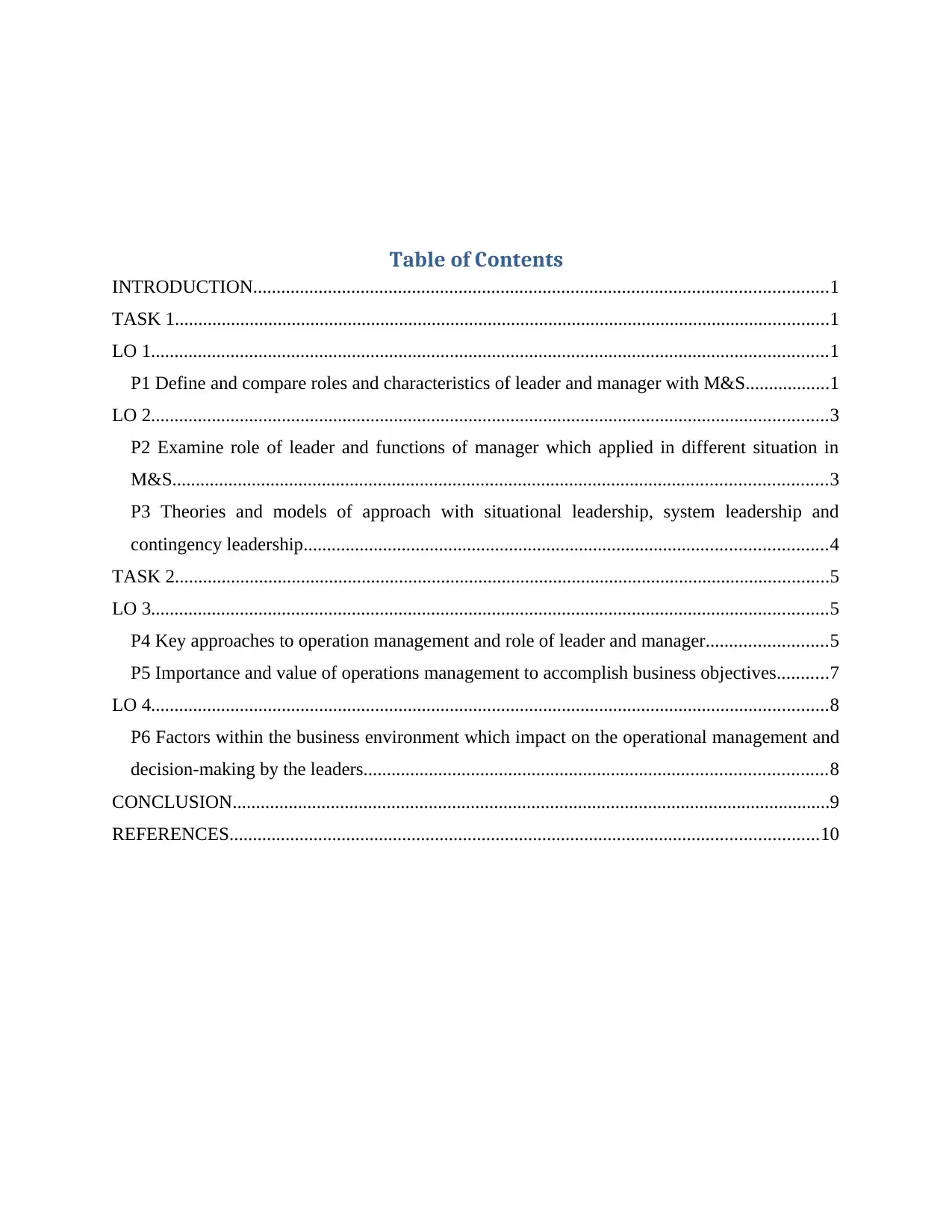
Table of Contents
INTRODUCTION...........................................................................................................................1
TASK 1............................................................................................................................................1
LO 1.................................................................................................................................................1
P1 Define and compare roles and characteristics of leader and manager with M&S..................1
LO 2.................................................................................................................................................3
P2 Examine role of leader and functions of manager which applied in different situation in
M&S............................................................................................................................................3
P3 Theories and models of approach with situational leadership, system leadership and
contingency leadership................................................................................................................4
TASK 2............................................................................................................................................5
LO 3.................................................................................................................................................5
P4 Key approaches to operation management and role of leader and manager..........................5
P5 Importance and value of operations management to accomplish business objectives...........7
LO 4.................................................................................................................................................8
P6 Factors within the business environment which impact on the operational management and
decision-making by the leaders...................................................................................................8
CONCLUSION................................................................................................................................9
REFERENCES..............................................................................................................................10
INTRODUCTION...........................................................................................................................1
TASK 1............................................................................................................................................1
LO 1.................................................................................................................................................1
P1 Define and compare roles and characteristics of leader and manager with M&S..................1
LO 2.................................................................................................................................................3
P2 Examine role of leader and functions of manager which applied in different situation in
M&S............................................................................................................................................3
P3 Theories and models of approach with situational leadership, system leadership and
contingency leadership................................................................................................................4
TASK 2............................................................................................................................................5
LO 3.................................................................................................................................................5
P4 Key approaches to operation management and role of leader and manager..........................5
P5 Importance and value of operations management to accomplish business objectives...........7
LO 4.................................................................................................................................................8
P6 Factors within the business environment which impact on the operational management and
decision-making by the leaders...................................................................................................8
CONCLUSION................................................................................................................................9
REFERENCES..............................................................................................................................10

INTRODUCTION
Management and operation consist important role in success of the organisation. In this
context, every business requires to implement elements in the systematic manner. It is the best
way to accomplish desire results (Hong, Koo and Jeong, 2015). In respect to this, present report
based on the Marks and Spencer which is one of the biggest retail sector business in the UK.
They are demonstrating functions and operations to attract customers in the systematic manner.
For gaining insight knowledge of the report, it covers roles of leaders and manager within the
enterprise. Furthermore, it includes difference between the roles and functions of both persons in
the company. In addition to this, it involves key approaches of the operation management that
determines successful results for functions. At last, it includes several elements to enhance
profits and revenue in the enterprise.
TASK 1
LO 1
P1 Define and compare roles and characteristics of leader and manager with M&S
Leadership is the process in which person set direction and vision for the group to
accomplish desired results. Therefore, it can be stated that leader set new direction. On the other
hand, management control and direct with people resources in the group. It includes principles
and values that have been established (Mahmud, Zahedi and Mahmud, 2017). Therefore, M & S
will easily achieve their targets in systematic way at workplace.
Basis Manager Leader
Characteristics Manager of M & S always
looking to increase their
profits and revenue in
systematic manner. They are
using activities that always
copy the same things at
workplace (Higuchi and Nec
Corporation, 2016).
Leaders are also determines
their functions and operations
but only for accomplish
desired goals and objectives.
They are demonstrating roles
and responsibility to
accomplish the desired results.
They are determines unique
concept to set the activities in
1
Management and operation consist important role in success of the organisation. In this
context, every business requires to implement elements in the systematic manner. It is the best
way to accomplish desire results (Hong, Koo and Jeong, 2015). In respect to this, present report
based on the Marks and Spencer which is one of the biggest retail sector business in the UK.
They are demonstrating functions and operations to attract customers in the systematic manner.
For gaining insight knowledge of the report, it covers roles of leaders and manager within the
enterprise. Furthermore, it includes difference between the roles and functions of both persons in
the company. In addition to this, it involves key approaches of the operation management that
determines successful results for functions. At last, it includes several elements to enhance
profits and revenue in the enterprise.
TASK 1
LO 1
P1 Define and compare roles and characteristics of leader and manager with M&S
Leadership is the process in which person set direction and vision for the group to
accomplish desired results. Therefore, it can be stated that leader set new direction. On the other
hand, management control and direct with people resources in the group. It includes principles
and values that have been established (Mahmud, Zahedi and Mahmud, 2017). Therefore, M & S
will easily achieve their targets in systematic way at workplace.
Basis Manager Leader
Characteristics Manager of M & S always
looking to increase their
profits and revenue in
systematic manner. They are
using activities that always
copy the same things at
workplace (Higuchi and Nec
Corporation, 2016).
Leaders are also determines
their functions and operations
but only for accomplish
desired goals and objectives.
They are demonstrating roles
and responsibility to
accomplish the desired results.
They are determines unique
concept to set the activities in
1
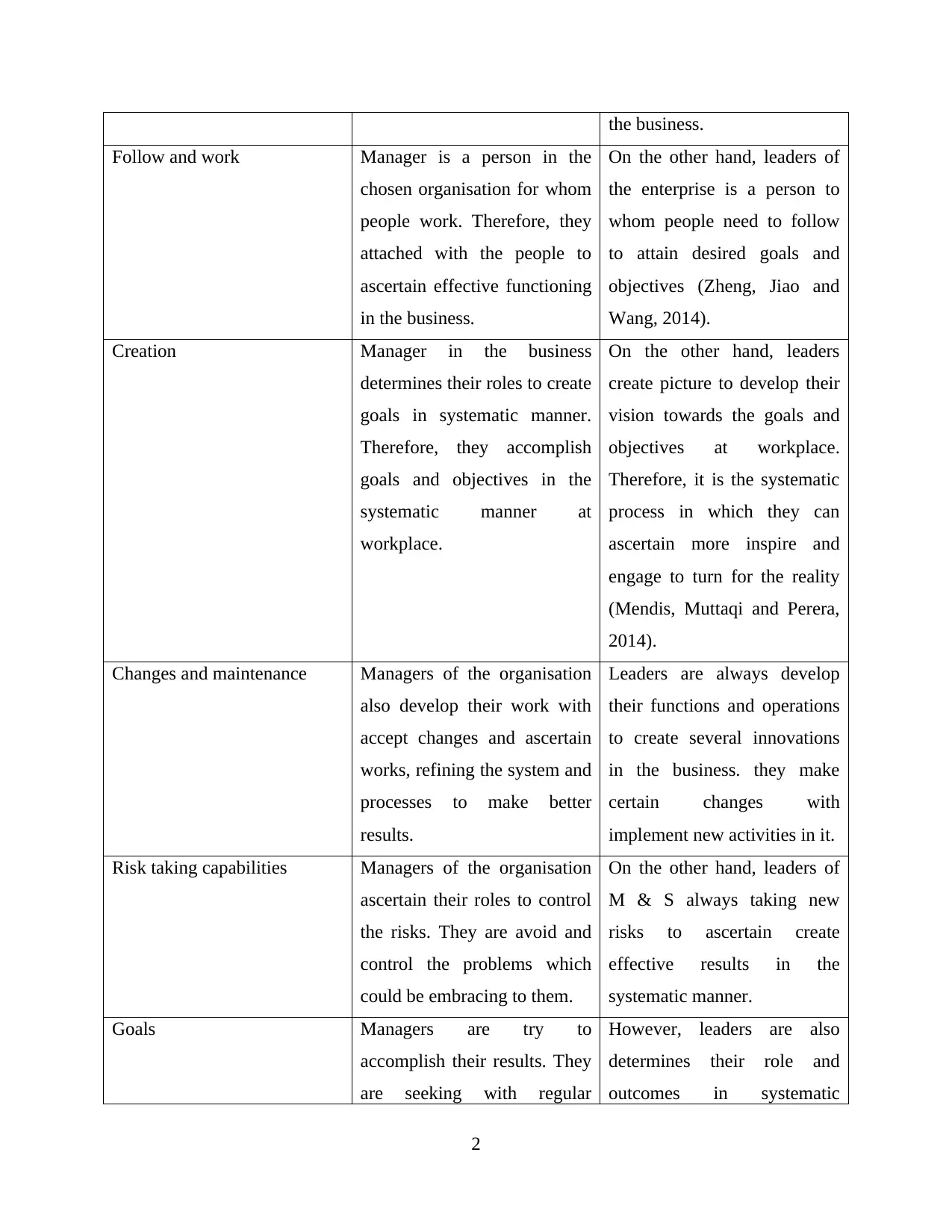
the business.
Follow and work Manager is a person in the
chosen organisation for whom
people work. Therefore, they
attached with the people to
ascertain effective functioning
in the business.
On the other hand, leaders of
the enterprise is a person to
whom people need to follow
to attain desired goals and
objectives (Zheng, Jiao and
Wang, 2014).
Creation Manager in the business
determines their roles to create
goals in systematic manner.
Therefore, they accomplish
goals and objectives in the
systematic manner at
workplace.
On the other hand, leaders
create picture to develop their
vision towards the goals and
objectives at workplace.
Therefore, it is the systematic
process in which they can
ascertain more inspire and
engage to turn for the reality
(Mendis, Muttaqi and Perera,
2014).
Changes and maintenance Managers of the organisation
also develop their work with
accept changes and ascertain
works, refining the system and
processes to make better
results.
Leaders are always develop
their functions and operations
to create several innovations
in the business. they make
certain changes with
implement new activities in it.
Risk taking capabilities Managers of the organisation
ascertain their roles to control
the risks. They are avoid and
control the problems which
could be embracing to them.
On the other hand, leaders of
M & S always taking new
risks to ascertain create
effective results in the
systematic manner.
Goals Managers are try to
accomplish their results. They
are seeking with regular
However, leaders are also
determines their role and
outcomes in systematic
2
Follow and work Manager is a person in the
chosen organisation for whom
people work. Therefore, they
attached with the people to
ascertain effective functioning
in the business.
On the other hand, leaders of
the enterprise is a person to
whom people need to follow
to attain desired goals and
objectives (Zheng, Jiao and
Wang, 2014).
Creation Manager in the business
determines their roles to create
goals in systematic manner.
Therefore, they accomplish
goals and objectives in the
systematic manner at
workplace.
On the other hand, leaders
create picture to develop their
vision towards the goals and
objectives at workplace.
Therefore, it is the systematic
process in which they can
ascertain more inspire and
engage to turn for the reality
(Mendis, Muttaqi and Perera,
2014).
Changes and maintenance Managers of the organisation
also develop their work with
accept changes and ascertain
works, refining the system and
processes to make better
results.
Leaders are always develop
their functions and operations
to create several innovations
in the business. they make
certain changes with
implement new activities in it.
Risk taking capabilities Managers of the organisation
ascertain their roles to control
the risks. They are avoid and
control the problems which
could be embracing to them.
On the other hand, leaders of
M & S always taking new
risks to ascertain create
effective results in the
systematic manner.
Goals Managers are try to
accomplish their results. They
are seeking with regular
However, leaders are also
determines their role and
outcomes in systematic
2
Secure Best Marks with AI Grader
Need help grading? Try our AI Grader for instant feedback on your assignments.

acknowledge and accolades.
Therefore, they set short terms
goals that assist to make
effective functioning in the
business (Lindström,
Källström and Kyösti, 2017).
manner. Therefore, they
ascertain long term targets in
the business to make creative
results.
LO 2
P2 Examine role of leader and functions of manager which applied in different situation in M&S
With the help of different roles and characteristics, leaders and manager ascertain their
effective functioning in the business. In this regard, different situations take place in M & S to
attain more effective results at workplace. Therefore, it assists to increase more profits and
revenue in the systematic manner (Mahmud, Zahedi and Mahmud, 2017). For accomplish
desired outcomes, the company take more roles of the different person through they are able to
develop creative results. Following are different situations in which roles of leaders and
managers develop their functions:
When the M & S require make changes, they need to concentrate on leadership qualities
to develop targets and goals in systematic manner. They need to assign roles and
responsibility to each person so that the business will develop their performances. In
addition to this, manager also plays their roles to set the goals and targets at workplace. It
is the systematic work in which organisation need to set their activities in proper manner
(Mohammadi, Soleymani and Mozafari, 2014).
Further, when business want to implement new products and services they need to
ascertain more functions at workplace. In this way, manager need to set targets through
they are able to deliver creative functioning at workplace. In the M & S, leaders need to
assess the customer demand so that they can lead to their team members accordingly. It is
the best way to achieve their targets and goals. On the other hand, manager need to
concentrate on the fund arrangement to implement new products and services in the
business (Hong, Koo and Jeong, 2015).
3
Therefore, they set short terms
goals that assist to make
effective functioning in the
business (Lindström,
Källström and Kyösti, 2017).
manner. Therefore, they
ascertain long term targets in
the business to make creative
results.
LO 2
P2 Examine role of leader and functions of manager which applied in different situation in M&S
With the help of different roles and characteristics, leaders and manager ascertain their
effective functioning in the business. In this regard, different situations take place in M & S to
attain more effective results at workplace. Therefore, it assists to increase more profits and
revenue in the systematic manner (Mahmud, Zahedi and Mahmud, 2017). For accomplish
desired outcomes, the company take more roles of the different person through they are able to
develop creative results. Following are different situations in which roles of leaders and
managers develop their functions:
When the M & S require make changes, they need to concentrate on leadership qualities
to develop targets and goals in systematic manner. They need to assign roles and
responsibility to each person so that the business will develop their performances. In
addition to this, manager also plays their roles to set the goals and targets at workplace. It
is the systematic work in which organisation need to set their activities in proper manner
(Mohammadi, Soleymani and Mozafari, 2014).
Further, when business want to implement new products and services they need to
ascertain more functions at workplace. In this way, manager need to set targets through
they are able to deliver creative functioning at workplace. In the M & S, leaders need to
assess the customer demand so that they can lead to their team members accordingly. It is
the best way to achieve their targets and goals. On the other hand, manager need to
concentrate on the fund arrangement to implement new products and services in the
business (Hong, Koo and Jeong, 2015).
3

In addition to this, another situation can be arises in which turnover will be occurs at
workplace. Therefore, manager and leaders of M & S need to take part through they are
able to deliver creative results at workplace. In this context, manager need to develop
their operations and functions through recruit and select new member at workplace. On
the other hand, leaders also need to provide proper direction to new members at
workplace of the chosen business. It is the systematic activity that assists to ascertain
more effective results (Mendis, Muttaqi and Perera, 2014).
Furthermore, the company also require concentrating on the activities to increase their
revenue and profits. Therefore, the company need to set new target market in new areas.
As results, it assists to develop more effective functioning in the business. In this
situation, M & S need to determine their goals and objectives to set their targets in
systematic manner. In this regard, leaders need to assess the market where the company
can expand their operations and functions in the systematic manner (Hong, Koo and
Jeong, 2015). Beside this, manager can concentrate on the activities that assists to set
different things at workplace.
P3 Theories and models of approach with situational leadership, system leadership and
contingency leadership
In order to develop the effective results and outcomes, M & S need to create effective results
at workplace. In this context, different kinds of theories implemented that assists to accomplish
desired results at workplace. In this way, the chosen business also motivates their employee to
give their participation towards the aims and objectives in the enterprise (Mohammadi,
Soleymani and Mozafari, 2014). Therefore, it is the systematic processes in which goals and
objectives will be accomplish to create effective functioning in the organisation. It includes
following theories and models to implement effective results:
Situational leadership: Situational leadership is the effective style in which systematic
outcomes will be develops. In this kind of leader and manager set their activities to
develop more effective functioning that can be influence to business. as per this
leadership style, M & S need to make changes continually to meet with the others in the
enterprise as per the situation. In this regard, leaders always trying to create shape to the
company. Leaders of the chosen business assist to manage functions and operations in the
systematic manner at workplace. Therefore, it is the systematic process tat could e
4
workplace. Therefore, manager and leaders of M & S need to take part through they are
able to deliver creative results at workplace. In this context, manager need to develop
their operations and functions through recruit and select new member at workplace. On
the other hand, leaders also need to provide proper direction to new members at
workplace of the chosen business. It is the systematic activity that assists to ascertain
more effective results (Mendis, Muttaqi and Perera, 2014).
Furthermore, the company also require concentrating on the activities to increase their
revenue and profits. Therefore, the company need to set new target market in new areas.
As results, it assists to develop more effective functioning in the business. In this
situation, M & S need to determine their goals and objectives to set their targets in
systematic manner. In this regard, leaders need to assess the market where the company
can expand their operations and functions in the systematic manner (Hong, Koo and
Jeong, 2015). Beside this, manager can concentrate on the activities that assists to set
different things at workplace.
P3 Theories and models of approach with situational leadership, system leadership and
contingency leadership
In order to develop the effective results and outcomes, M & S need to create effective results
at workplace. In this context, different kinds of theories implemented that assists to accomplish
desired results at workplace. In this way, the chosen business also motivates their employee to
give their participation towards the aims and objectives in the enterprise (Mohammadi,
Soleymani and Mozafari, 2014). Therefore, it is the systematic processes in which goals and
objectives will be accomplish to create effective functioning in the organisation. It includes
following theories and models to implement effective results:
Situational leadership: Situational leadership is the effective style in which systematic
outcomes will be develops. In this kind of leader and manager set their activities to
develop more effective functioning that can be influence to business. as per this
leadership style, M & S need to make changes continually to meet with the others in the
enterprise as per the situation. In this regard, leaders always trying to create shape to the
company. Leaders of the chosen business assist to manage functions and operations in the
systematic manner at workplace. Therefore, it is the systematic process tat could e
4

adopted at workplace. In certain situation, leader gives direction and training to achieve
their goals and objectives. In this kind of situational leadership, leaders are develops their
outcomes that can be make more effective results. For the chosen business, this kind of
leadership style ascertains their targets and goals in systematic way at workplace.
System leadership: Systematic leadership style also facilitates the different conditions to
make certain changes in the progress and outcomes of the business. Individual in the
business also ascertain their activities that are needed to perform task. Main aim of this
leadership style ascertain with M & S to face challenges in the organisation. It assists to
make effective results to foster and collective leadership within the organisation. Core
capabilities of system leaders also develop in the systematic manner. With this regard,
systematic leadership style also helps to make more effective functioning in the business.
It is the best way to make sure that goals and objectives will be set with different
activities (Higuchi and Nec Corporation, 2016).
Contingency leadership: Contingency leadership also develops with ascertain effective
results. This theory emphasis on to create effective leadership to match style with right
situation. Therefore, M & S studying different leaders with distinctive context so that
they are assume that targets and goals effective system. In this kind of leadership theory,
different elements included such as leader member relation, task structure, positional
power, etc. (Lindström, Källström and Kyösti, 2017). With the help of contingency
model, the organisation can build the relationship significant mistrust and insecurity with
the effective functioning. Highly structured tasks and also create to accomplish their
objectives in systematic manner. In addition to this, in the chosen business enterprise
contingency theory also develop directive results at workplace.
TASK 2
LO 3
P4 Key approaches to operation management and role of leader and manager
Operation management of M & S is the effective element that makes creative results in the
organisation. In this regard, the selected business need to set standard through they are able
implement effective activities that helps to increases the profit of chosen business. In this regard,
following are different key approaches exist that play by leader and mangers with different role:
5
their goals and objectives. In this kind of situational leadership, leaders are develops their
outcomes that can be make more effective results. For the chosen business, this kind of
leadership style ascertains their targets and goals in systematic way at workplace.
System leadership: Systematic leadership style also facilitates the different conditions to
make certain changes in the progress and outcomes of the business. Individual in the
business also ascertain their activities that are needed to perform task. Main aim of this
leadership style ascertain with M & S to face challenges in the organisation. It assists to
make effective results to foster and collective leadership within the organisation. Core
capabilities of system leaders also develop in the systematic manner. With this regard,
systematic leadership style also helps to make more effective functioning in the business.
It is the best way to make sure that goals and objectives will be set with different
activities (Higuchi and Nec Corporation, 2016).
Contingency leadership: Contingency leadership also develops with ascertain effective
results. This theory emphasis on to create effective leadership to match style with right
situation. Therefore, M & S studying different leaders with distinctive context so that
they are assume that targets and goals effective system. In this kind of leadership theory,
different elements included such as leader member relation, task structure, positional
power, etc. (Lindström, Källström and Kyösti, 2017). With the help of contingency
model, the organisation can build the relationship significant mistrust and insecurity with
the effective functioning. Highly structured tasks and also create to accomplish their
objectives in systematic manner. In addition to this, in the chosen business enterprise
contingency theory also develop directive results at workplace.
TASK 2
LO 3
P4 Key approaches to operation management and role of leader and manager
Operation management of M & S is the effective element that makes creative results in the
organisation. In this regard, the selected business need to set standard through they are able
implement effective activities that helps to increases the profit of chosen business. In this regard,
following are different key approaches exist that play by leader and mangers with different role:
5
Paraphrase This Document
Need a fresh take? Get an instant paraphrase of this document with our AI Paraphraser
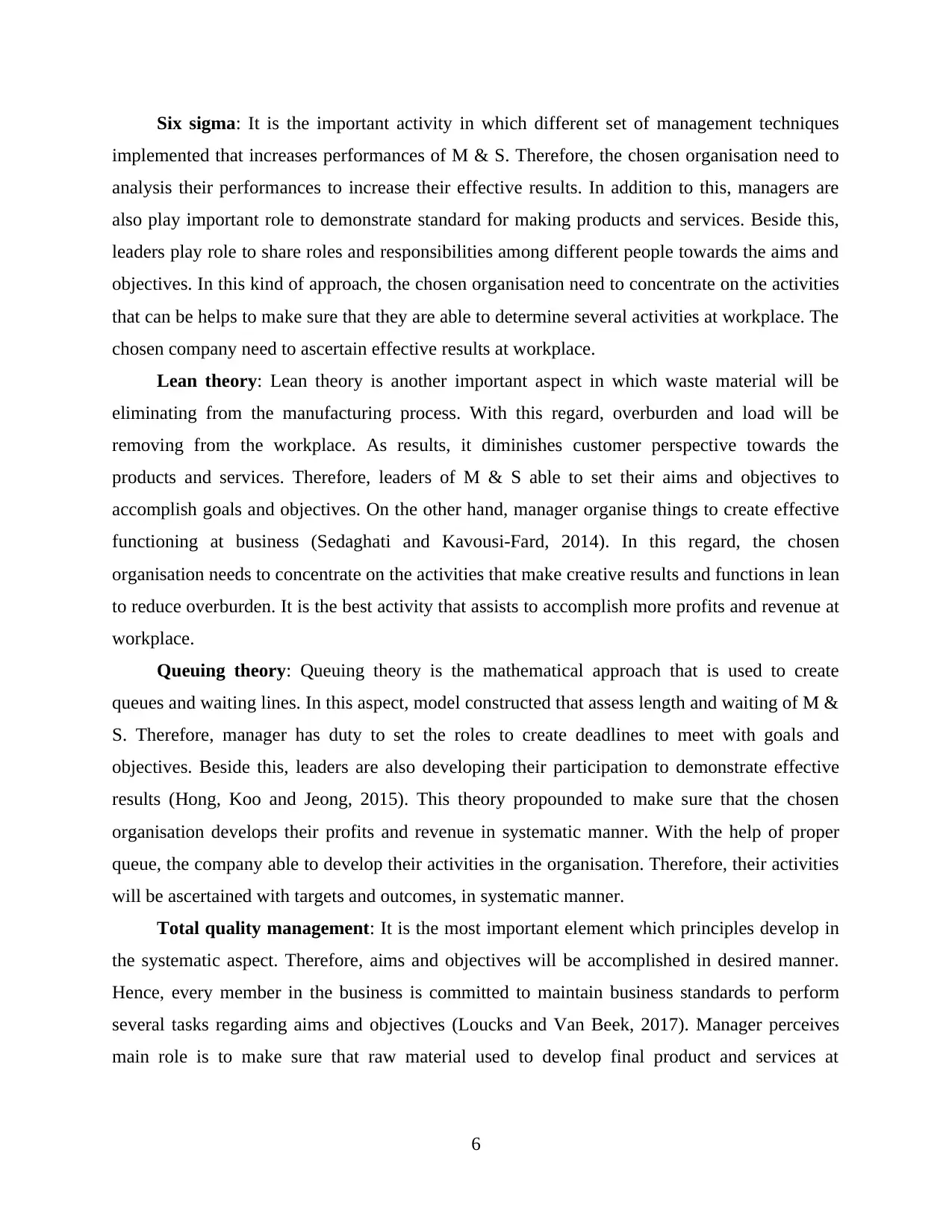
Six sigma: It is the important activity in which different set of management techniques
implemented that increases performances of M & S. Therefore, the chosen organisation need to
analysis their performances to increase their effective results. In addition to this, managers are
also play important role to demonstrate standard for making products and services. Beside this,
leaders play role to share roles and responsibilities among different people towards the aims and
objectives. In this kind of approach, the chosen organisation need to concentrate on the activities
that can be helps to make sure that they are able to determine several activities at workplace. The
chosen company need to ascertain effective results at workplace.
Lean theory: Lean theory is another important aspect in which waste material will be
eliminating from the manufacturing process. With this regard, overburden and load will be
removing from the workplace. As results, it diminishes customer perspective towards the
products and services. Therefore, leaders of M & S able to set their aims and objectives to
accomplish goals and objectives. On the other hand, manager organise things to create effective
functioning at business (Sedaghati and Kavousi-Fard, 2014). In this regard, the chosen
organisation needs to concentrate on the activities that make creative results and functions in lean
to reduce overburden. It is the best activity that assists to accomplish more profits and revenue at
workplace.
Queuing theory: Queuing theory is the mathematical approach that is used to create
queues and waiting lines. In this aspect, model constructed that assess length and waiting of M &
S. Therefore, manager has duty to set the roles to create deadlines to meet with goals and
objectives. Beside this, leaders are also developing their participation to demonstrate effective
results (Hong, Koo and Jeong, 2015). This theory propounded to make sure that the chosen
organisation develops their profits and revenue in systematic manner. With the help of proper
queue, the company able to develop their activities in the organisation. Therefore, their activities
will be ascertained with targets and outcomes, in systematic manner.
Total quality management: It is the most important element which principles develop in
the systematic aspect. Therefore, aims and objectives will be accomplished in desired manner.
Hence, every member in the business is committed to maintain business standards to perform
several tasks regarding aims and objectives (Loucks and Van Beek, 2017). Manager perceives
main role is to make sure that raw material used to develop final product and services at
6
implemented that increases performances of M & S. Therefore, the chosen organisation need to
analysis their performances to increase their effective results. In addition to this, managers are
also play important role to demonstrate standard for making products and services. Beside this,
leaders play role to share roles and responsibilities among different people towards the aims and
objectives. In this kind of approach, the chosen organisation need to concentrate on the activities
that can be helps to make sure that they are able to determine several activities at workplace. The
chosen company need to ascertain effective results at workplace.
Lean theory: Lean theory is another important aspect in which waste material will be
eliminating from the manufacturing process. With this regard, overburden and load will be
removing from the workplace. As results, it diminishes customer perspective towards the
products and services. Therefore, leaders of M & S able to set their aims and objectives to
accomplish goals and objectives. On the other hand, manager organise things to create effective
functioning at business (Sedaghati and Kavousi-Fard, 2014). In this regard, the chosen
organisation needs to concentrate on the activities that make creative results and functions in lean
to reduce overburden. It is the best activity that assists to accomplish more profits and revenue at
workplace.
Queuing theory: Queuing theory is the mathematical approach that is used to create
queues and waiting lines. In this aspect, model constructed that assess length and waiting of M &
S. Therefore, manager has duty to set the roles to create deadlines to meet with goals and
objectives. Beside this, leaders are also developing their participation to demonstrate effective
results (Hong, Koo and Jeong, 2015). This theory propounded to make sure that the chosen
organisation develops their profits and revenue in systematic manner. With the help of proper
queue, the company able to develop their activities in the organisation. Therefore, their activities
will be ascertained with targets and outcomes, in systematic manner.
Total quality management: It is the most important element which principles develop in
the systematic aspect. Therefore, aims and objectives will be accomplished in desired manner.
Hence, every member in the business is committed to maintain business standards to perform
several tasks regarding aims and objectives (Loucks and Van Beek, 2017). Manager perceives
main role is to make sure that raw material used to develop final product and services at
6
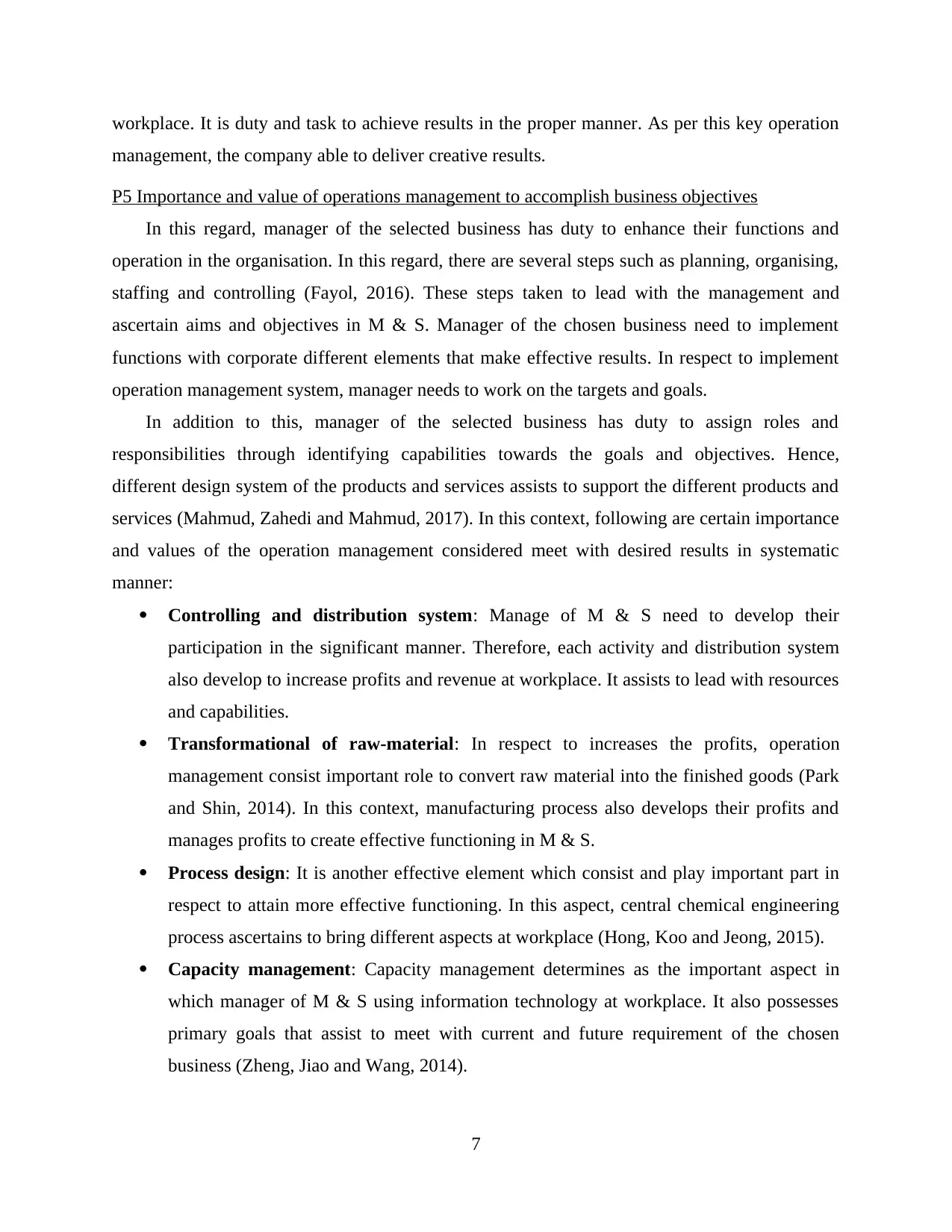
workplace. It is duty and task to achieve results in the proper manner. As per this key operation
management, the company able to deliver creative results.
P5 Importance and value of operations management to accomplish business objectives
In this regard, manager of the selected business has duty to enhance their functions and
operation in the organisation. In this regard, there are several steps such as planning, organising,
staffing and controlling (Fayol, 2016). These steps taken to lead with the management and
ascertain aims and objectives in M & S. Manager of the chosen business need to implement
functions with corporate different elements that make effective results. In respect to implement
operation management system, manager needs to work on the targets and goals.
In addition to this, manager of the selected business has duty to assign roles and
responsibilities through identifying capabilities towards the goals and objectives. Hence,
different design system of the products and services assists to support the different products and
services (Mahmud, Zahedi and Mahmud, 2017). In this context, following are certain importance
and values of the operation management considered meet with desired results in systematic
manner:
Controlling and distribution system: Manage of M & S need to develop their
participation in the significant manner. Therefore, each activity and distribution system
also develop to increase profits and revenue at workplace. It assists to lead with resources
and capabilities.
Transformational of raw-material: In respect to increases the profits, operation
management consist important role to convert raw material into the finished goods (Park
and Shin, 2014). In this context, manufacturing process also develops their profits and
manages profits to create effective functioning in M & S.
Process design: It is another effective element which consist and play important part in
respect to attain more effective functioning. In this aspect, central chemical engineering
process ascertains to bring different aspects at workplace (Hong, Koo and Jeong, 2015).
Capacity management: Capacity management determines as the important aspect in
which manager of M & S using information technology at workplace. It also possesses
primary goals that assist to meet with current and future requirement of the chosen
business (Zheng, Jiao and Wang, 2014).
7
management, the company able to deliver creative results.
P5 Importance and value of operations management to accomplish business objectives
In this regard, manager of the selected business has duty to enhance their functions and
operation in the organisation. In this regard, there are several steps such as planning, organising,
staffing and controlling (Fayol, 2016). These steps taken to lead with the management and
ascertain aims and objectives in M & S. Manager of the chosen business need to implement
functions with corporate different elements that make effective results. In respect to implement
operation management system, manager needs to work on the targets and goals.
In addition to this, manager of the selected business has duty to assign roles and
responsibilities through identifying capabilities towards the goals and objectives. Hence,
different design system of the products and services assists to support the different products and
services (Mahmud, Zahedi and Mahmud, 2017). In this context, following are certain importance
and values of the operation management considered meet with desired results in systematic
manner:
Controlling and distribution system: Manage of M & S need to develop their
participation in the significant manner. Therefore, each activity and distribution system
also develop to increase profits and revenue at workplace. It assists to lead with resources
and capabilities.
Transformational of raw-material: In respect to increases the profits, operation
management consist important role to convert raw material into the finished goods (Park
and Shin, 2014). In this context, manufacturing process also develops their profits and
manages profits to create effective functioning in M & S.
Process design: It is another effective element which consist and play important part in
respect to attain more effective functioning. In this aspect, central chemical engineering
process ascertains to bring different aspects at workplace (Hong, Koo and Jeong, 2015).
Capacity management: Capacity management determines as the important aspect in
which manager of M & S using information technology at workplace. It also possesses
primary goals that assist to meet with current and future requirement of the chosen
business (Zheng, Jiao and Wang, 2014).
7
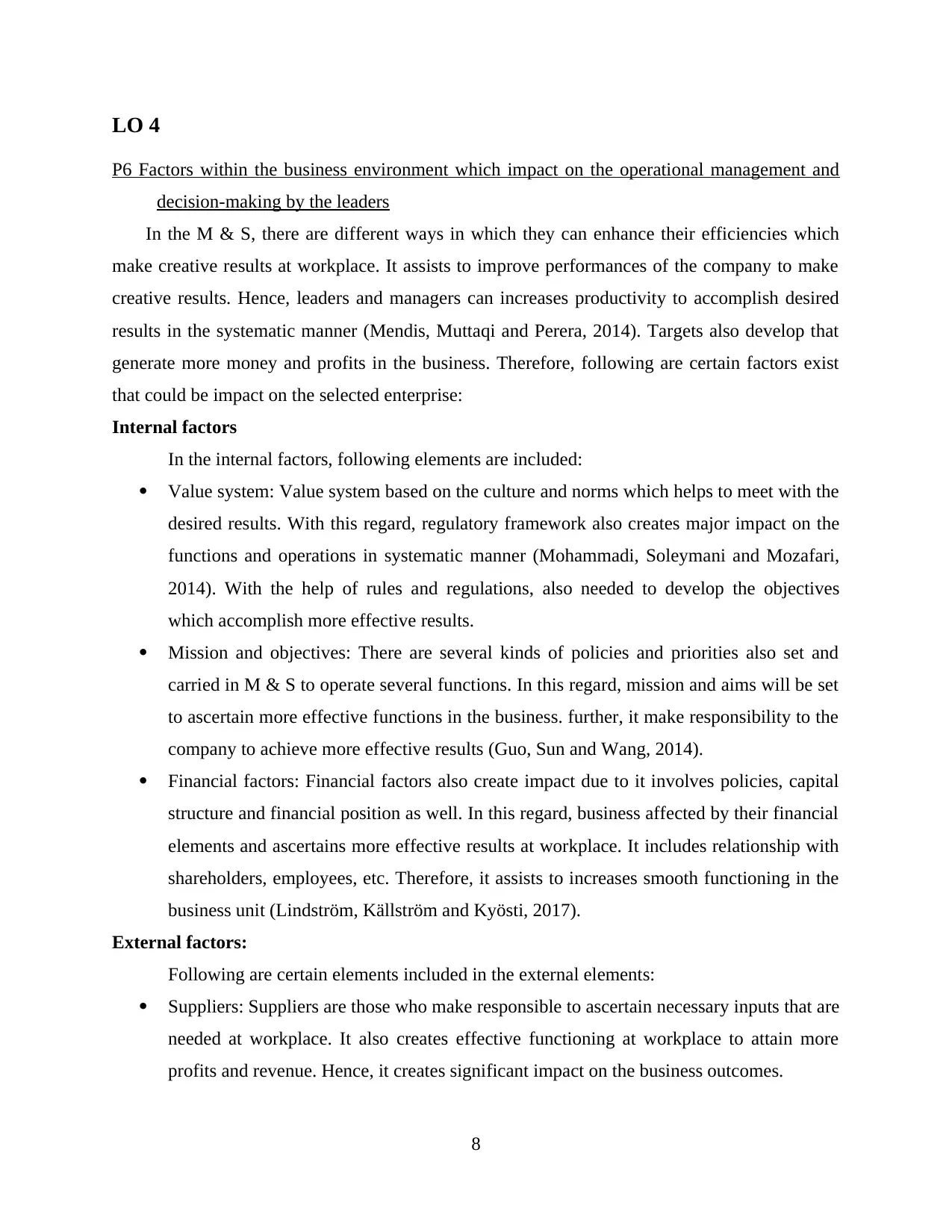
LO 4
P6 Factors within the business environment which impact on the operational management and
decision-making by the leaders
In the M & S, there are different ways in which they can enhance their efficiencies which
make creative results at workplace. It assists to improve performances of the company to make
creative results. Hence, leaders and managers can increases productivity to accomplish desired
results in the systematic manner (Mendis, Muttaqi and Perera, 2014). Targets also develop that
generate more money and profits in the business. Therefore, following are certain factors exist
that could be impact on the selected enterprise:
Internal factors
In the internal factors, following elements are included:
Value system: Value system based on the culture and norms which helps to meet with the
desired results. With this regard, regulatory framework also creates major impact on the
functions and operations in systematic manner (Mohammadi, Soleymani and Mozafari,
2014). With the help of rules and regulations, also needed to develop the objectives
which accomplish more effective results.
Mission and objectives: There are several kinds of policies and priorities also set and
carried in M & S to operate several functions. In this regard, mission and aims will be set
to ascertain more effective functions in the business. further, it make responsibility to the
company to achieve more effective results (Guo, Sun and Wang, 2014).
Financial factors: Financial factors also create impact due to it involves policies, capital
structure and financial position as well. In this regard, business affected by their financial
elements and ascertains more effective results at workplace. It includes relationship with
shareholders, employees, etc. Therefore, it assists to increases smooth functioning in the
business unit (Lindström, Källström and Kyösti, 2017).
External factors:
Following are certain elements included in the external elements:
Suppliers: Suppliers are those who make responsible to ascertain necessary inputs that are
needed at workplace. It also creates effective functioning at workplace to attain more
profits and revenue. Hence, it creates significant impact on the business outcomes.
8
P6 Factors within the business environment which impact on the operational management and
decision-making by the leaders
In the M & S, there are different ways in which they can enhance their efficiencies which
make creative results at workplace. It assists to improve performances of the company to make
creative results. Hence, leaders and managers can increases productivity to accomplish desired
results in the systematic manner (Mendis, Muttaqi and Perera, 2014). Targets also develop that
generate more money and profits in the business. Therefore, following are certain factors exist
that could be impact on the selected enterprise:
Internal factors
In the internal factors, following elements are included:
Value system: Value system based on the culture and norms which helps to meet with the
desired results. With this regard, regulatory framework also creates major impact on the
functions and operations in systematic manner (Mohammadi, Soleymani and Mozafari,
2014). With the help of rules and regulations, also needed to develop the objectives
which accomplish more effective results.
Mission and objectives: There are several kinds of policies and priorities also set and
carried in M & S to operate several functions. In this regard, mission and aims will be set
to ascertain more effective functions in the business. further, it make responsibility to the
company to achieve more effective results (Guo, Sun and Wang, 2014).
Financial factors: Financial factors also create impact due to it involves policies, capital
structure and financial position as well. In this regard, business affected by their financial
elements and ascertains more effective results at workplace. It includes relationship with
shareholders, employees, etc. Therefore, it assists to increases smooth functioning in the
business unit (Lindström, Källström and Kyösti, 2017).
External factors:
Following are certain elements included in the external elements:
Suppliers: Suppliers are those who make responsible to ascertain necessary inputs that are
needed at workplace. It also creates effective functioning at workplace to attain more
profits and revenue. Hence, it creates significant impact on the business outcomes.
8
Secure Best Marks with AI Grader
Need help grading? Try our AI Grader for instant feedback on your assignments.
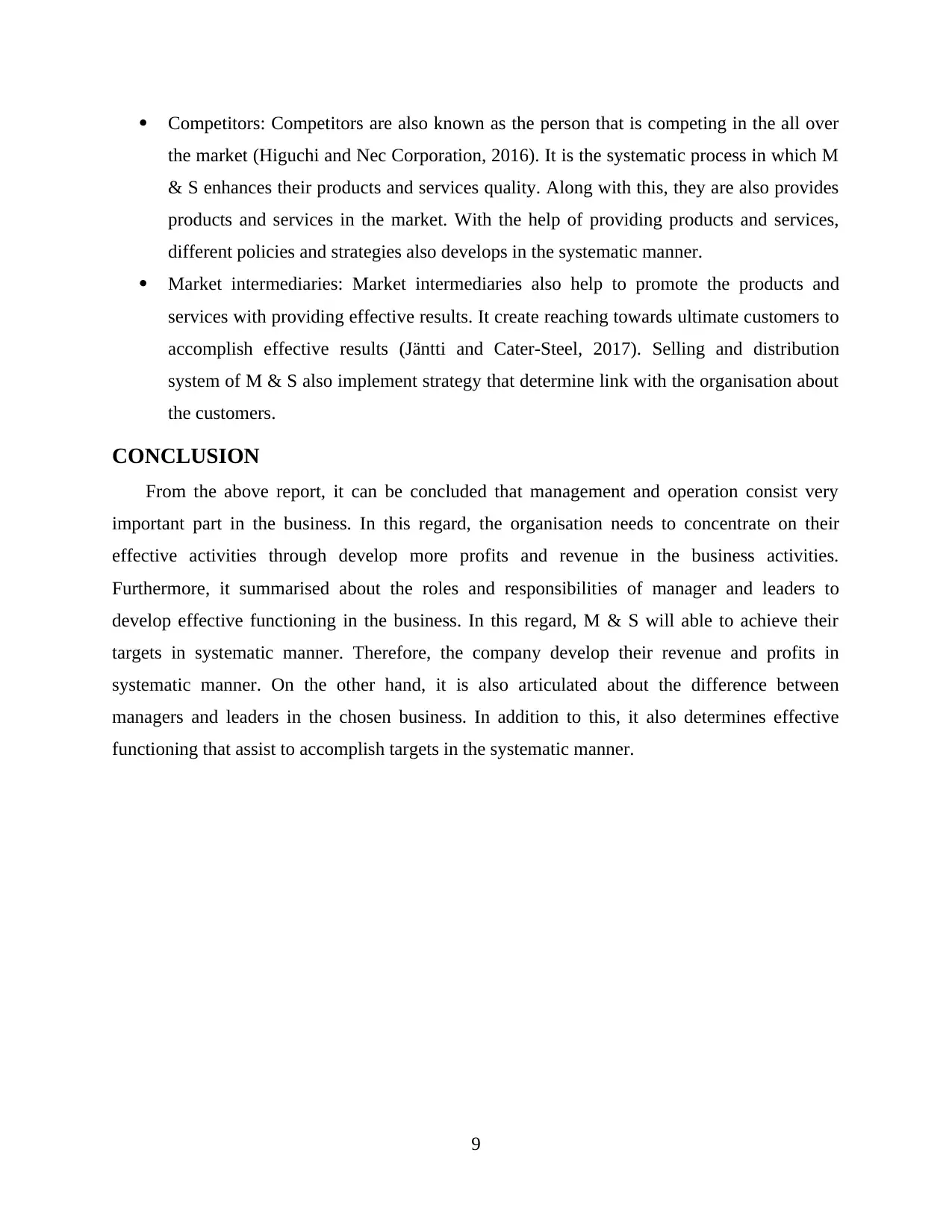
Competitors: Competitors are also known as the person that is competing in the all over
the market (Higuchi and Nec Corporation, 2016). It is the systematic process in which M
& S enhances their products and services quality. Along with this, they are also provides
products and services in the market. With the help of providing products and services,
different policies and strategies also develops in the systematic manner.
Market intermediaries: Market intermediaries also help to promote the products and
services with providing effective results. It create reaching towards ultimate customers to
accomplish effective results (Jäntti and Cater-Steel, 2017). Selling and distribution
system of M & S also implement strategy that determine link with the organisation about
the customers.
CONCLUSION
From the above report, it can be concluded that management and operation consist very
important part in the business. In this regard, the organisation needs to concentrate on their
effective activities through develop more profits and revenue in the business activities.
Furthermore, it summarised about the roles and responsibilities of manager and leaders to
develop effective functioning in the business. In this regard, M & S will able to achieve their
targets in systematic manner. Therefore, the company develop their revenue and profits in
systematic manner. On the other hand, it is also articulated about the difference between
managers and leaders in the chosen business. In addition to this, it also determines effective
functioning that assist to accomplish targets in the systematic manner.
9
the market (Higuchi and Nec Corporation, 2016). It is the systematic process in which M
& S enhances their products and services quality. Along with this, they are also provides
products and services in the market. With the help of providing products and services,
different policies and strategies also develops in the systematic manner.
Market intermediaries: Market intermediaries also help to promote the products and
services with providing effective results. It create reaching towards ultimate customers to
accomplish effective results (Jäntti and Cater-Steel, 2017). Selling and distribution
system of M & S also implement strategy that determine link with the organisation about
the customers.
CONCLUSION
From the above report, it can be concluded that management and operation consist very
important part in the business. In this regard, the organisation needs to concentrate on their
effective activities through develop more profits and revenue in the business activities.
Furthermore, it summarised about the roles and responsibilities of manager and leaders to
develop effective functioning in the business. In this regard, M & S will able to achieve their
targets in systematic manner. Therefore, the company develop their revenue and profits in
systematic manner. On the other hand, it is also articulated about the difference between
managers and leaders in the chosen business. In addition to this, it also determines effective
functioning that assist to accomplish targets in the systematic manner.
9
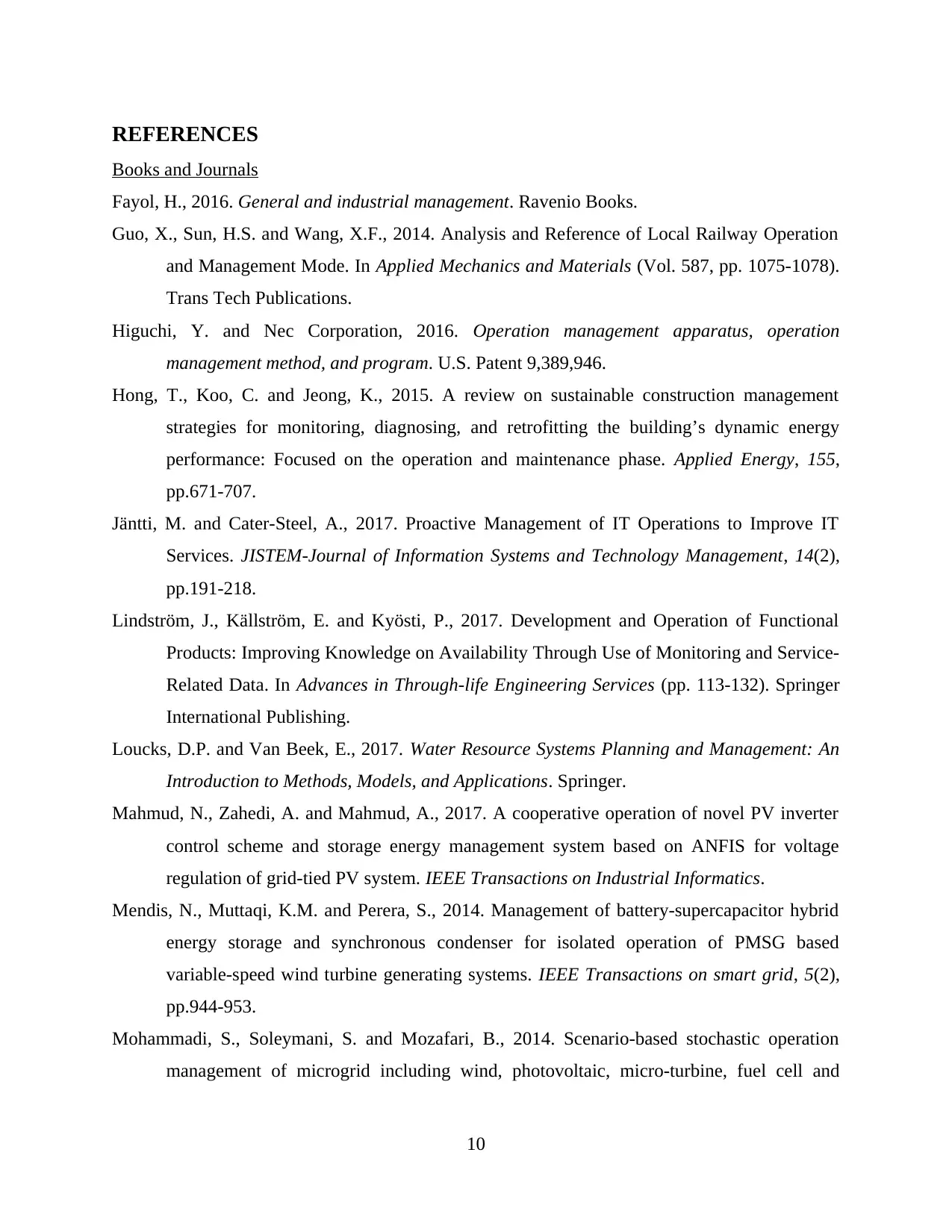
REFERENCES
Books and Journals
Fayol, H., 2016. General and industrial management. Ravenio Books.
Guo, X., Sun, H.S. and Wang, X.F., 2014. Analysis and Reference of Local Railway Operation
and Management Mode. In Applied Mechanics and Materials (Vol. 587, pp. 1075-1078).
Trans Tech Publications.
Higuchi, Y. and Nec Corporation, 2016. Operation management apparatus, operation
management method, and program. U.S. Patent 9,389,946.
Hong, T., Koo, C. and Jeong, K., 2015. A review on sustainable construction management
strategies for monitoring, diagnosing, and retrofitting the building’s dynamic energy
performance: Focused on the operation and maintenance phase. Applied Energy, 155,
pp.671-707.
Jäntti, M. and Cater-Steel, A., 2017. Proactive Management of IT Operations to Improve IT
Services. JISTEM-Journal of Information Systems and Technology Management, 14(2),
pp.191-218.
Lindström, J., Källström, E. and Kyösti, P., 2017. Development and Operation of Functional
Products: Improving Knowledge on Availability Through Use of Monitoring and Service-
Related Data. In Advances in Through-life Engineering Services (pp. 113-132). Springer
International Publishing.
Loucks, D.P. and Van Beek, E., 2017. Water Resource Systems Planning and Management: An
Introduction to Methods, Models, and Applications. Springer.
Mahmud, N., Zahedi, A. and Mahmud, A., 2017. A cooperative operation of novel PV inverter
control scheme and storage energy management system based on ANFIS for voltage
regulation of grid-tied PV system. IEEE Transactions on Industrial Informatics.
Mendis, N., Muttaqi, K.M. and Perera, S., 2014. Management of battery-supercapacitor hybrid
energy storage and synchronous condenser for isolated operation of PMSG based
variable-speed wind turbine generating systems. IEEE Transactions on smart grid, 5(2),
pp.944-953.
Mohammadi, S., Soleymani, S. and Mozafari, B., 2014. Scenario-based stochastic operation
management of microgrid including wind, photovoltaic, micro-turbine, fuel cell and
10
Books and Journals
Fayol, H., 2016. General and industrial management. Ravenio Books.
Guo, X., Sun, H.S. and Wang, X.F., 2014. Analysis and Reference of Local Railway Operation
and Management Mode. In Applied Mechanics and Materials (Vol. 587, pp. 1075-1078).
Trans Tech Publications.
Higuchi, Y. and Nec Corporation, 2016. Operation management apparatus, operation
management method, and program. U.S. Patent 9,389,946.
Hong, T., Koo, C. and Jeong, K., 2015. A review on sustainable construction management
strategies for monitoring, diagnosing, and retrofitting the building’s dynamic energy
performance: Focused on the operation and maintenance phase. Applied Energy, 155,
pp.671-707.
Jäntti, M. and Cater-Steel, A., 2017. Proactive Management of IT Operations to Improve IT
Services. JISTEM-Journal of Information Systems and Technology Management, 14(2),
pp.191-218.
Lindström, J., Källström, E. and Kyösti, P., 2017. Development and Operation of Functional
Products: Improving Knowledge on Availability Through Use of Monitoring and Service-
Related Data. In Advances in Through-life Engineering Services (pp. 113-132). Springer
International Publishing.
Loucks, D.P. and Van Beek, E., 2017. Water Resource Systems Planning and Management: An
Introduction to Methods, Models, and Applications. Springer.
Mahmud, N., Zahedi, A. and Mahmud, A., 2017. A cooperative operation of novel PV inverter
control scheme and storage energy management system based on ANFIS for voltage
regulation of grid-tied PV system. IEEE Transactions on Industrial Informatics.
Mendis, N., Muttaqi, K.M. and Perera, S., 2014. Management of battery-supercapacitor hybrid
energy storage and synchronous condenser for isolated operation of PMSG based
variable-speed wind turbine generating systems. IEEE Transactions on smart grid, 5(2),
pp.944-953.
Mohammadi, S., Soleymani, S. and Mozafari, B., 2014. Scenario-based stochastic operation
management of microgrid including wind, photovoltaic, micro-turbine, fuel cell and
10

energy storage devices. International Journal of Electrical Power & Energy Systems, 54,
pp.525-535.
Park, J.B. and Shin, S.J., 2014. The Comparative Study on Safety Factors at Elevator
Management System Operation. The Journal of The Institute of Internet, Broadcasting
and Communication, 14(6), pp.159-162.
Sedaghati, R. and Kavousi-Fard, A., 2014. A hybrid fuzzy-PEM stochastic framework to solve
the optimal operation management of distribution feeder reconfiguration considering
wind turbines. Journal of Intelligent & Fuzzy Systems, 26(4), pp.1711-1721.
Zheng, G.J., Jiao, J.L. and Wang, X.W., 2014. The Development of the Intelligent Anti-
Disoperation Operation Order System. In Advanced Materials Research (Vol. 962, pp.
2919-2923). Trans Tech Publications.
11
pp.525-535.
Park, J.B. and Shin, S.J., 2014. The Comparative Study on Safety Factors at Elevator
Management System Operation. The Journal of The Institute of Internet, Broadcasting
and Communication, 14(6), pp.159-162.
Sedaghati, R. and Kavousi-Fard, A., 2014. A hybrid fuzzy-PEM stochastic framework to solve
the optimal operation management of distribution feeder reconfiguration considering
wind turbines. Journal of Intelligent & Fuzzy Systems, 26(4), pp.1711-1721.
Zheng, G.J., Jiao, J.L. and Wang, X.W., 2014. The Development of the Intelligent Anti-
Disoperation Operation Order System. In Advanced Materials Research (Vol. 962, pp.
2919-2923). Trans Tech Publications.
11
1 out of 13
Related Documents
Your All-in-One AI-Powered Toolkit for Academic Success.
+13062052269
info@desklib.com
Available 24*7 on WhatsApp / Email
![[object Object]](/_next/static/media/star-bottom.7253800d.svg)
Unlock your academic potential
© 2024 | Zucol Services PVT LTD | All rights reserved.





